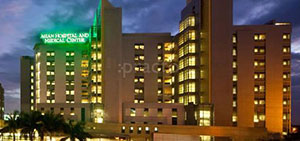Sexual Habits & Cervical Cancer


First Published in Billy Termite Blogspot
Image credit: Snap_it: pixabay.com through Creative Commons CC0
By Rebecca B. Singson, M.D., FPOGS
Cervical cancer is the most common cancer in the female reproductive tract and the second most common cancer in women second to breast cancer. In 2005 alone, our National cancer Institute statistics reveals that there are 7,225 new cases of cervical cancer in the Philippines. Sadly, two-thirds of these cases are diagnosed when they are beyond the operative stage, such that 32.3 percent of them die in one year. The irony is that it is completely preventable, or at let diagnosable before it becomes life threatening.
Over a century ago, it was observed that women who developed cervical cancer were those with husbands who traveled frequently, or who had penile cancer, or whose wife had died of cervical cancer, or those who fleeted from one sexual partner to another. It was not until the past two decades that research has shown that one of the main causes of the cervical cancer is a virus called the Human Papillomavirus.
“It is a virus acquired through sexual contact and infects the lining cells of the genitalia and can be detected in 5-40 percent of women of reproductive age.”World experts on the Human Papillomavirus from 18 countries gathered recently to organize the Asia Oceania Genital Infection & Neoplasia (AOGIN), a research organization on genital infection: to share their latest research on the virus and to discuss global initiatives on cervical cancer prevention. It was revealed that there are 70 distinct site-specific types of this virus (meaning they will grow on one part of the body and not another). Of these, about 35 types are found in the anus and the genital areas, causing warts and cervical cancer, the most notorious being types 16 and 18. It is a virus acquired through sexual contact and infects the lining cells of the genitalia and can be detected in 5-40 percent of women of reproductive age. It has been found that infections are relatively short-lived lasting usually 8-10 months. This indicates that our bodies are indeed are capable of clearing the virus which is why in women over 30 years old, the prevalence drops down to 5-10 percent. It is in this group of women with persistent infections who are not able to clear the virus from their bodies that cancer in the cervix now has a chance to progress.
Because of the advances in our knowledge linking the human Papillomavirus to the causation of cervical cancer, it became necessary to develop the HPV test that would indicate if a woman is positive for the high risk strains of the virus that would increase her risk for cervical cancer.
The HPV DNA test using the Hybrid Capture II System, developed by a company called Digene, recently came out with a commercially available test which has a sensitivity of 90 percent and negative predictive value of over 90 percent. Available in major hospitals, the test entails taking cervical swabs, much like a Pap smear, using the brush from the Digene Cervical Sampler, Pap smear collected with a broom collection device and rinsed in the ThinPrep System PreservCyt solution may also be used to provide the same specimen for HPV testing. You can in fact ask your gynecologist to perform the test when you get your next pap smear.
It is important to understand the risk factors that increase your chances of acquiring the virus as well the co-existing factors that mediate progression to cancer.
“they evaluated cervical cancer risk in relation to sexual behavior, histories of specific venereal diseases, and hygiene practices, it was noted that early age at first sexual intercourse and increasing number of sexual partners were associated with significantly increased risk for cervical cancer.”In a case-control study of women with invasive cervical cancer in four Latin American countries where they evaluated cervical cancer risk in relation to sexual behavior, histories of specific venereal diseases, and hygiene practices, it was noted that early age at first sexual intercourse and increasing number of sexual partners were associated with significantly increased risk for cervical cancer. Risk increased over twofold among women reporting first intercourse at 14 to 15 years of age, compared to those who started after 20 years old. Having an uncircumcised male partner, cigarette smoking, an impaired immune system (such as AIDS patients), and poor nutrition (diet low on fruits and vegetables, and deficient in Vitamin A, C and folic acid) all increase one’s risk for cervical cancer.
“Risk increased over twofold among women reporting first intercourse at 14 to 15 years of age, compared to those who started after 20 years old.”It is vital for us to educate our youth that it is prudent for men as well as women to delay having sex as late as possible. This is because the earlier age you engage in sexual intercourse, the higher the chances for having multiple sexual partners which will increase the chances of acquiring the carcinogenic HPV.
“Promiscuity can be potentially lethal if one acquires the HPV virus or worse, AIDS, so sex should be limited to a significant other or to one destined to be a life partner. It was also found choosing a circumcised male partner can also decrease one’s risk for cervical cancer..”Men should realize that although the virus does not cause much harm to them in general other than having occasional causing unsightly penile warts, they can transmit the virus to their unsuspecting partners.
Promiscuity can be potentially lethal if one acquires the HPV virus or worse, AIDS, so sex should be limited to a significant other or to one destined to be a life partner. It was also found choosing a circumcised male partner can also decrease one’s risk for cervical cancer.
The HPV test may be recommended to all women over 30 years and above together with a pap smear. If both tests run up a negative, and the last three Pap smears were normal, you can even defer your next Pap smear test for three years. If your tests turns up positive, you may either opt for a repeat testing in one year or go for a colposcopy of the cervix to check for possible precancerous changes.
(Dr. Rebecca B. Singson is a Fellow of both Obstetrics and Gynecologic Society and Philippine Society of Cervical Pathology and Colposcopy and may be emailed at obmd@surfshop.net.hp)
TESTIMONY on ROBOTIC OPERATION
By: Satisfied Patient
In June of this year, I suffered from abdominal pains which increased in intensity and frequency. Upon consultation and observation with my long-time OB-Gyne, Dra. Rebecca Singson, it was diagnosed that I needed to have an appendectomy and hysterectomy. Of course, the prospect of having what Dra Singson called an extensive surgery, caused me some apprehensions.
Dra Singson said I could have it done through Laparoscopic Surgery, but if there was further procedures to be done, she would have to do an incision, which would take a longer time to heal. I asked her on other options, and she told me about Robotic Surgery, which was less risky and whatever other procedures would be needed, it could be done without any incision needed. She highly recommended it, and trusting Dra Singson, my family and I agreed on the Robotic Operation procedure.
On the day of the procedure/operation, I found myself more relaxed and not anxious as I thought I would be. I had been praying and I knew all would be well, with God in control and being under Dra Singson’s capable hands. When I was wheeled into the Operating Room of St. Lukes Global, vey lucid, since no oral relaxant was given to me, I was not intimidated in spite of all the instruments and team of medical personnel there. I felt quite secure. Dra. Singson even “introduced” me to the robot she would use in the procedure. I was then put to sleep under general anaesthesia. The procedure took some hours as the doctors made sure it was thoroughly administered. I did not feel anything throughout as I was in deep sleep.
I woke up some hours later, already in the Recovery Room. There was no pain whatsoever in the 4 tiny incisions placed. However, I was having bad gas pains, which I found out was due to air being blown in the abdominal cavity as protection from the instruments that were put in the abdomen by the doctor. I was told that I was to release the gas through burping and flatulence.
After being brought into my room, I continuously burped but found great relief when a nurse told me to sit down, which enabled me to flatulate. That relieved me a lot. I was also encouraged to start walking little by little so healing would be faster.
After 24 hours, with all body signs stable, Dra Singson sent me home to continue to recover. I was walking but taking it slow. I felt fine and I knew I was well on the way to recovery. A week after, I went to the hair salon, and people were surprised with my fast recuperation, saying that I did not even look like I had undergone both appendectomy and hysterectomy.
Now, eight weeks have passed, and Dra Singson has given me the go-signal to return to my normal activities. I know that if an incision was done, I still would be recuperating. But I am back to my normal activities, and truly glad and thankful we opted for Robotic Surgery.
Robotic Surgery in the Philippines: Dr. Rebecca Singson’s Speciality

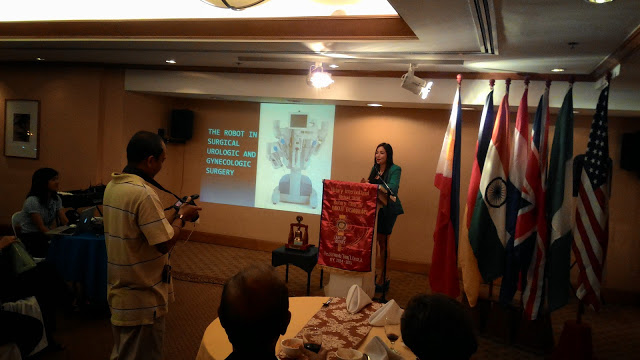
Robotic Surgery Philippines
Finally Robotic Surgery is available in the Philippines.
Unless you are a man from Krypton, suffering from a major illness once or twice in your lifetime will be inevitable. Even the most seemingly healthy person with all the exercise and “right food” will come down with something when that person hits middle age. Some get ill at a younger age, especially those who have “inherited” certain conditions from their parents or ancestors. Not until recently, surgery is almost always the last recourse for the lot of us because surgery is painful. Painful for the body as well as the finances. With traditional surgery, you will be in the hospital for weeks, some maybe even months. Though initial costs are lower than robotic surgery, the final cost will eventually equal, if not surpass robotic surgery, if you include the cost of the lengthy hospital stay, incidental expenses and lost income/ opportunities. Guaranteed, robotic surgery will do the same thing as traditional surgery, but will also have you up and about in three days after the operation. On the fourth day or earlier, you will be strong enough to hail your own cab. By the following Monday, you will be strong enough to return to the office and after another week, it will all be a memory, sans the illness.
Dr. Rebecca Singson: surgeon with a vision
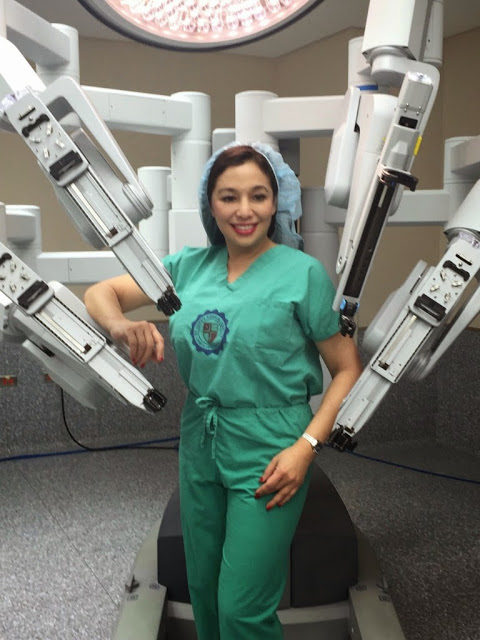
Dr. Singson is one of the doctors who is known to be ahead of her time. She is a highly-renowned gynecologist and one of the few doctors in the Philippines internationally accredited to even operate the Da Vince Si surgical robot, which is the only one in operation here in the Philippines at the St. Luke’s Medical Center at the Global City, Taguig. Along with her surgery team, she also does cancer surgery, among her usual gynecological duties of hysterectomies (removal of the uterus) and mymectomies (removal of myomas). Also if a woman wants to get pregnant, Dr. Singson is also your best bet. Graduating with honors at the University of the Philippines, Dr. Singson is a pioneer in the use of the Da Vinci system for surgeries that would otherwise be near-fatal for diabetics, older people and those with existing conditions who may not survive open surgery.
SLMC invested US$ 2.6 Million to make this technology available to the Pinoy.
Fast recovery: the gift of Robotic Surgery
Why choose robotic surgery? The speed of recovery is phenomenal. Never before has there been any kind of procedure that actually allowed you to heal weeks faster compared to being hacked open. You lose less blood during the procedure, because the robotic arms are very precise. Compared to traditional laparoscopy, the robotic surgeon gets to see a highly magnified picture of the area being operated on, effectively avoiding the cutting of blood vessels that might cause terrible bleeding. Plus there are four robotic arms compared to the laparoscopic surgeon’s two, with the robotic arms having a more flexible range of motion, even far more than the human hand. It’s like having equally knowledgeable helpers around, but the surgeon is not near the patient during all this. The distance lessens the incidence of infection.
Robotic surgery may just be the technology you need to save your life. For more information, call:
St. Luke’s Medical Center Global City
32nd Street and 5th Bonifacio Global City, Taguig City, Metro Manila
Room 305, Medical Arts Building
Tel No.: +632-789-7700 loc. 7305
Direct Line: +639178003446
Clinic hours: Mon/Tues/ Thurs 2-4PM/ Fri 4-6PM
Susan Orillos

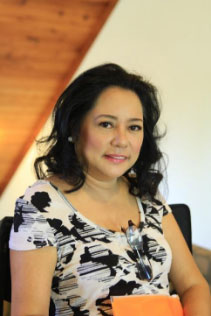 Last year, August 2015, I underwent Robotic Surgery to remove my Cervix and Uterus as I was diagnosed with Endometriosis. At the age of 56, I was still having my periods then. Prior to my operation, I was praying so hard that God will bless me with a very good doctor.
Last year, August 2015, I underwent Robotic Surgery to remove my Cervix and Uterus as I was diagnosed with Endometriosis. At the age of 56, I was still having my periods then. Prior to my operation, I was praying so hard that God will bless me with a very good doctor.
My daughter and I were in search for the best Ob-Gyn; we read and studied the qualifications of different doctors, the cases they’ve dealt with, etc. Upon reading so many articles, there was this doctor who caught our attention and whom we were very impressed with – and that’s Dra. Rebecca Singson.
Remembering my first meeting with her, I already saw a friendly, prayerful and well-experienced doctor in the field of Obstetrics. After her explaining why I should undergo the operation and the advantages of Robotic Surgery, I had my operation scheduled right away.
I believe Robotic Surgery is a very safe procedure as I only have very small cuts/ incisions on my belly. Few hours after the operation, I was already able to walk to the CR as I didn’t feel any pain. I stayed in the hospital for only 3 days, and on the 5th day, I was already out in the mall!
A year after my operation, I had my check-up again and underwent different tests, i.e. Ovary & Breast Ultrasounds and Mammogram. With God’s grace, all results were okay.
To Dra. Rebecca, I thank you for not only being a very good doctor, but also a FRIEND to all your patients, who are afraid and confused during those challenging times of their lives. You are indeed, God’s answer to my prayers. May God bless you always!
How to undergo a major surgery without missing a day of work
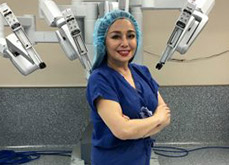
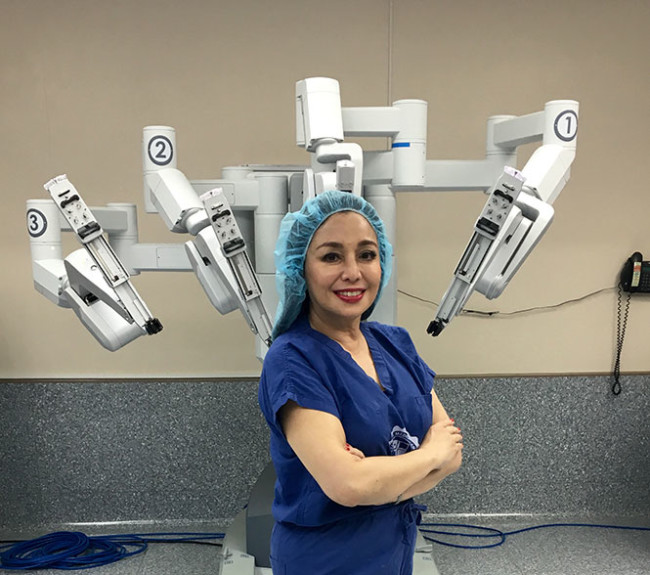
It is possible to not miss a day of work after a complicated major surgery, if done with Robotic Surgery . I recently performed a Robotic Surgery to remove the uterus, cervix, Fallopian tubes and ovaries of a high level bank executive who had multiple myomas in her uterus with ovarian cysts . She was a complicated case. Because she had a previous laparoscopic removal of her left ovarian cyst for endometriosis (robotic surgery was not even around back then), she had massive adhesions of her ovaries to the intestines and to the back of her uterus which made her case really difficult and complicated . But thanks to robotic surgery on a Friday , she went home in 36 hours and was back to work, full blast in the bank that Monday, without canceling a single meeting, and got her sick leave converted to vacation leave at a future more opportune time !! She is 6 weeks post Robotic Surgery and never had a glitch in her post operative course!!
Robotic surgery is the way to go!! It minimalizes the usual difficult and long recovery of a major surgery !! Hooray for Robotic Surgery !
Lyn Alayon: About My Robotic Surgery in the Philippines
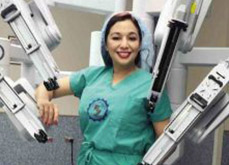
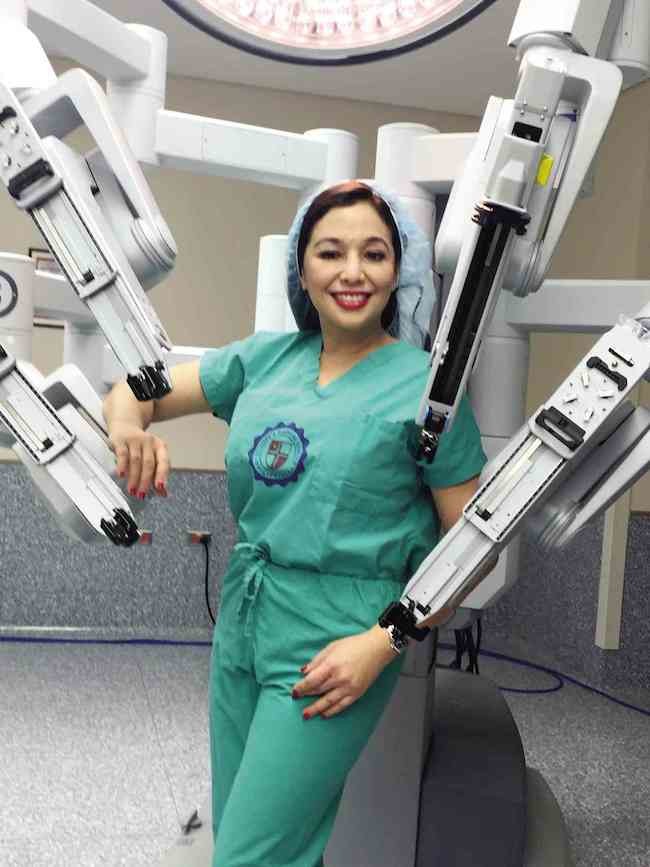
Robotic Surgeon Rebecca Singson and the Da Vinci Robot used for Robotic Surgery in the Philippines
The Results of my Robotic Surgery in the Philippines
Last February 2016, I had a consultation with Dr. Rebecca Singson, a Robotic Surgery in the Philippines specialist, because of severe menstrual cramps and low back pain. I was diagnosed with adenomyoma, adenomyosis and bilateral endometriotic cysts. Within the same month, I underwent robotic laparoscopy at St. Luke’s Medical Centre Global City.
When I first came to the clinic, I was welcomed by her friendly nurse, Ms. Maika. She patiently answers all my questions and always shows willingness to extend help whenever I need assistance. Dr. Rebecca Singson is a good gynecologist. She is direct to the point and explained my condition well.
Series of laboratory tests and scans were done preoperatively. Nurse Maika helped me to follow up my results that made things organized.
After all the results were released, Dr. Rebecca Singson scheduled my surgery on the earliest date possible.
I was so scared because that was my first time to undergo surgery. The stress of knowing that I will be going under the knife is really terrifying. But knowing that Dr. Rebecca Singson is the well experienced surgeon in this field of robotic laparoscopy, it made me feel more secured. I know I am in good hands.
Surgery day came. They wheeled me into the operating theatre complex at 5:00 am. Bunch of friendly nurses came and greeted me. They checked my vital signs, did a skin test, and explained the preoperative preparations and what to expect after the surgery. Few minutes later, the anesthesiologist, Dr. Sukarno Gani came. He run through my medical history and gave me information about the anesthesia. Just before I was transferred go the operating theatre table, I saw Dr. Rebecca Singson already seated at the Da Vinci robot console. She came to me and gave reassurance.
It took almost 7 hours to complete my surgery. As I was returned to the ward, my husband told me that my case was really complicated, it was long and challenging surgery, but I tolerated it well!
Two days after the surgery I was discharged from the hospital, thereafter series of follow up consultations. Ms. Maika never failed in giving appointment reminders.
I appreciate that Dr. Rebecca Singson took a holistic approach on my condition. She advised me to do a food intolerance test in order for me to have well-guarded diet after the surgery. My condition is related on consuming inflammatory foods. It is really helpful knowing what the foods I should avoid are and what are the substitutes for it.
Now it’s been 3 months since I had the surgery. I can say that I am doing well and really benefited from the surgery. I only have 4 small incision scars where they docked in the Da Vinci robot arms and scope. Considering the size, complexity and location of the cysts, it was really a great decision to do it by robotic laparoscopy as strongly advised by Dr. Rebecca Singson, rather than doing it by conventional laparoscopy.
Thank you Dr. Rebecca Singson, to the entire team of St. Luke’s Medical Centre Global City, and as well as to her clinic nurse, Ms. Maika who helped me all throughout my treatment.
I am really grateful with the utmost care and excellent service that the whole medical team gave me.
Lyn Alayon
Robotic Surgery Philippines: Anna Litonjua, Uterine Fibroids
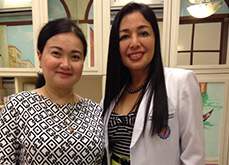
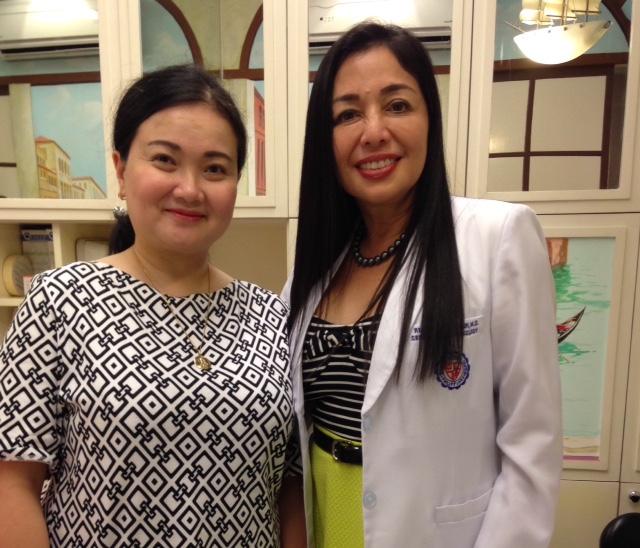 I was diagnosed with uterine fibroids and was heavily bleeding for two years. I kept on postponing visits to see an OB-Gyne. I was afraid of undergoing the knife until pain and sever bleeding became unbearable. I was rushed to the hospital last May 29, with a life-threatening blood count of only 5.8. Normal values are between 11.2-15.7.
I was diagnosed with uterine fibroids and was heavily bleeding for two years. I kept on postponing visits to see an OB-Gyne. I was afraid of undergoing the knife until pain and sever bleeding became unbearable. I was rushed to the hospital last May 29, with a life-threatening blood count of only 5.8. Normal values are between 11.2-15.7.
From the emergency room, I was ordered for confinement and blood transfusion. The uterine fibroids have increased in size. The goal was to get my hemoglobin to normal levels before surgery. But after 4 bags of blood transfusion, it was still below normal. Dr. Rebecca Singson explained that it was too risky to undergo open surgery since my hemoglobin was at a life threatening level. My immune system was already compromised. She further explained that Robotic Surgery Philippines would be less invasive therefore there would be less blood loss and faster recovery. This made me decide to undergo hysterectomy by robotic surgery which was more appropriate to my condition.
Robotic Surgery Philippines Saved My life
Robotic Surgery Philippines took place 6/01 and I was able to sit and walk around the next day. I was released from the hospital 6/04 and was able to drive a week after surgery. I am very thankful I underwent robotic surgery and to be in the good hands of a caring doctor like Dr. Rebecca Singson, otherwise, I wouldn’t be able to do normal activities that quick had I opted for open surgery. This procedure actually saved my life.
Editors Note:
Dr. Rebecca Singson holds her clinics at Asian Hospital, St. Lukes Medical Center in Global City, Taguig, and at the Makati Medical Center. You can find her schedule here. Please feel free to call any of her clinics and set an appointment at your convenience. Find out how Robotic Surgery in the Philippines could help you.
Marites Ampil, successful Robotic Surgery Philippines
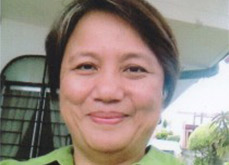
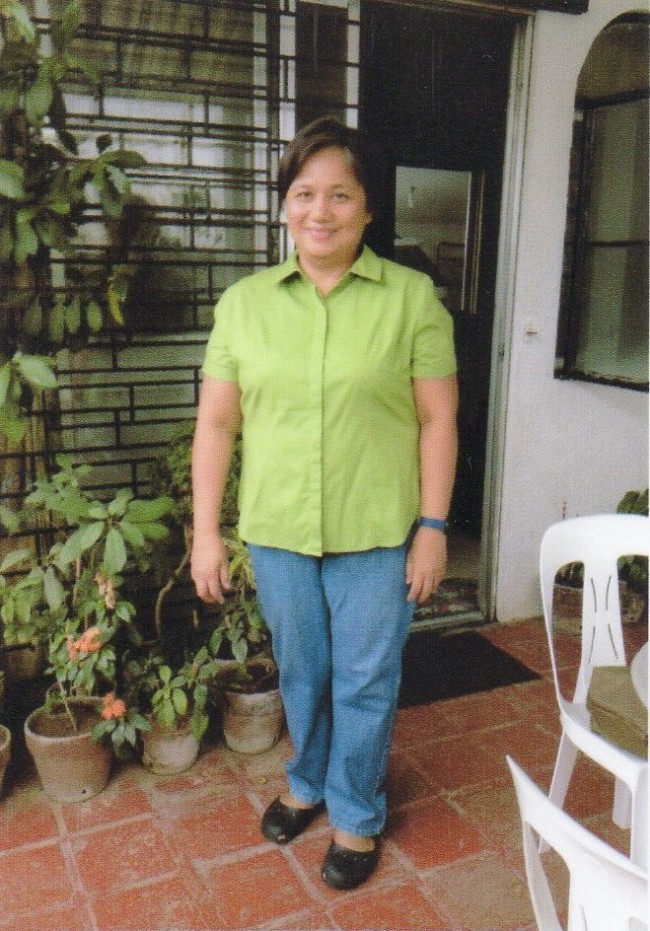
Miss Teresita Ampil who underwent a successful Robotic Surgery Philippines
My name is Marites Ampil. I am 54 years old. I work full time and caregiver/guardian to my 88 year old mother.
Three years ago, I was diagnosed with Multiple Myoma. I was not prepared to undergo surgery then as the thought of a large abdominal incision plus long post-surgical recovery, long hospital stay scared me to death. I never had surgery before. I could not imagine my mother not being cared for me immediately after surgery.
In April of this year, complications of my condition worsened and I had to make a decision that it is time for surgery. I was extremely anxious. I did not know any gynecologist surgeon.
I was given 5 pages of the list of surgeons at the hospital information. I did not understand the titles of the surgeons and what they can offer. I prayed hard for enlightenment. The printed copy of the list of gynecologic surgeons hardly helped as it was hardly legible. I believe there was some divine intervention. I randomly picked the name of Dr. Rebecca Singson, who specializes in Robotic Surgery Philippines.
I consulted with Dr. Singson, who offered Robotic Assisted Technology, considering my home situation and apprehensions. I still had no clue. I was reassured that this is a minimally invasive procedure and hospital stay is also minimal. I was still extremely anxious.
Dr. Singson and her team were very reassuring.
Dr. Singson performed Robotic Assisted Hysterectomy and I was up on my feet 12 hours after my robotic surgery philippines. My apprehensions were all sorted. I had four very small incisions- 1 cm each in size.
Considering the volume of the diseased uterus, I find it extremely incredible that such diseased organ was surgically removed not through traditional large abdominal incision. Pain was also relatively controlled.
I was discharged home after 2 days. My heartfelt gratitude to the surgical skills of Dr. Rebecca Singson and the Robotic Technology.
Thank you to the surgical and nursing team of St. Luke’s Medical Center Global City.
Now I am back with my mother who is likewise grateful for the short and safe hospital stay.









